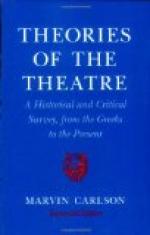Of course there are many minor means of emphasis in the theatre, but most of these are artificial and mechanical. The proverbial lime-light is one of the most effective. The intensity of the dream scene in Sir Henry Irving’s performance of The Bells was due largely to the way in which the single figure of Mathias was silhouetted by a ray of light against a shadowy and inscrutable background ominous with voices.
In this materialistic age, actors even resort to blandishments of costume to give their parts a special emphasis. Our leading ladies are more richly clad than the minor members of their companies. Even the great Mansfield resorted in his performance of Brutus to the indefensible expedient of changing his costume act by act and dressing always in exquisite and subtle colors, while the other Romans, Cassius included, wore the same togas of unaffected white throughout the play. This was a fault in emphasis.
A novel and interesting device of emphasis in stage-direction was introduced by Mr. Forbes-Robertson in his production of The Passing of the Third Floor Back. This dramatic parable by Mr. Jerome K. Jerome deals with the moral regeneration of eleven people, who are living in a Bloomsbury boarding-house, through the personal influence of a Passer-by, who is the Spirit of Love incarnate; and this effect is accomplished in a succession of dialogues, in which the Stranger talks at length with one boarder after another. It is necessary, for reasons of reality, that in each of the dialogues the Passer-by and his interlocutor




